Overview of Startups Developing Artificial Intelligence for the Energy Sector
Abstract
:1. Introduction
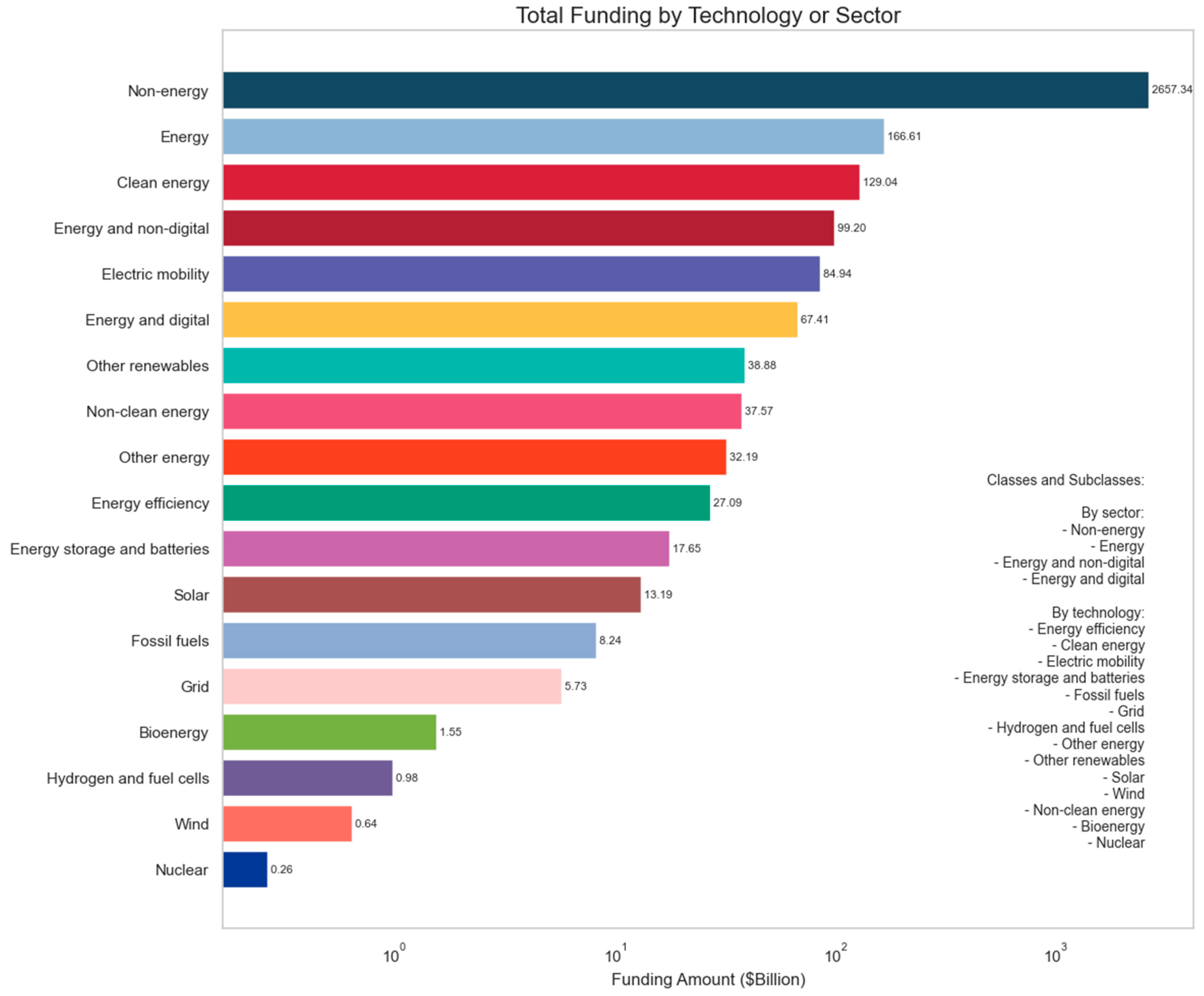
2. Artificial Intelligence
3. Quantum Computing
4. Business Models and Risk of Investing in Startups
4.1. Failure Rate Risk
4.2. Financial Risks
4.3. Market Risks
4.4. Operational Risk
4.5. Regulatory Risk
4.6. Technological Risks
5. Startups
6. Top Startups Developing Energy Sector with Artificial Intelligence
7. Discussion and Future Outlook
8. Conclusions
Author Contributions
Funding
Institutional Review Board Statement
Informed Consent Statement
Data Availability Statement
Conflicts of Interest
Abbreviations
| Abbreviation | Full Form |
| AI | Artificial Intelligence |
| QC | Quantum Computing |
| IoT | Internet of Things |
| ML | Machine Learning |
| DL | Deep Learning |
| NLP | Natural Language Processing |
| RL | Reinforcement Learning |
| IEUS | Interconnected Energy Units |
| IEU | Independent Energy Units |
| BMI | Business Model Innovation |
| BM | Business Model |
| R&D | Research and Development |
| VC | Venture Capital |
| CAGR | Compound Annual Growth Rate |
| GDP | Gross Domestic Product |
| IEA | International Energy Agency |
| VAR | Vector Autoregression |
| PwC | PricewaterhouseCoopers |
| QML | Quantum Machine Learning |
| CCS | Carbon Capture and Storage |
| CCU | Carbon Capture and Utilization |
| HVAC | Heating, Ventilation, and Air Conditioning |
| PV | Photovoltaic |
| TCE | Turbo Control Efficiency |
References
- Li, Q.; Zou, G.; Zeng, W.; Gao, J.; He, F.; Zhang, Y. ESG guidance and AI support for power systems analytics in the energy industry. Sci. Rep. 2024, 14, 11347. [Google Scholar]
- Bibri, S.E.; Alexandre, A.; Sharifi, A.; Krogstie, J. Environmentally sustainable smart cities and their converging AI, IoT, and big data technologies and solutions: An integrated approach to an extensive literature review. Energy Inform. 2023, 6, 9. [Google Scholar] [CrossRef] [PubMed]
- Camacho, J.d.J.; Aguirre, B.; Ponce, P.; Anthony, B.; Molina, A. Leveraging AI to Bolster the Energy Sector in Smart Cities: A Literature Review. Energies 2024, 17, 353. [Google Scholar] [CrossRef]
- Ebrahimian, H.; Barmayoon, S.; Mohammadi, M.; Ghadimi, N. The Price Prediction for the Energy Market Based on a New Method. Econ. Res.-Ekonomska Istraživanja 2018, 31, 313–337. [Google Scholar] [CrossRef]
- Eslami, M.; Moghadam, H.A.; Zayandehroodi, H.; Ghadimi, N. A New Formulation to Reduce the Number of Variables and Constraints to Expedite SCUC in Bulky Power Systems. Proc. Natl. Acad. Sci. India Sect. A Phys. Sci. 2018, 89, 311–321. [Google Scholar] [CrossRef]
- Sari, R.; Voyvoda, E.; Lacey-Barnacle, M.; Karababa, E.; Topal, C.; Islambay, D. Energy Justice: A Social Sciences and Humanities Cross-Cutting Theme Report; Shape Energy: Cambridge, UK, 2017; Available online: https://open.metu.edu.tr/handle/11511/75461 (accessed on 6 July 2024).
- Entezari, A.; Aghaei, J.; Khodaei, A.; Fotuhi-Firuzabad, M. Artificial intelligence and machine learning in energy systems: A bibliographic perspective. Energy Strategy Rev. 2023, 45, 101017. [Google Scholar] [CrossRef]
- Akal, M. Modeling World Energy Use Efficiency, Price, and GDP. Energy Sources Part B Econ. Plan. Policy 2016, 11, 911–919. [Google Scholar] [CrossRef]
- GDP per Unit of Energy Use (Constant 2021 PPP $ per kg of Oil Equivalent). The World Bank. Available online: https://data.worldbank.org/indicator/EG.GDP.PUSE.KO.PP.KD (accessed on 6 July 2024).
- IEA. World Energy Outlook 2023; IEA: Paris, France, 2023; Available online: https://www.iea.org/reports/world-energy-outlook-2023 (accessed on 24 July 2024).
- Davis, M.W. Distributed resource electric power systems offer significant advantages over central station generation and T & D power systems. II. In Proceedings of the IEEE Power Engineering Society Summer Meeting, Chicago, IL, USA, 21–25 July 2002. [Google Scholar]
- Hirsch, A.; Parag, Y.; Guerrero, J. Microgrids: A Review of Technologies, Key Drivers, and Outstanding Issues. Renew. Sustain. Energy Rev. 2018, 90, 402–411. [Google Scholar] [CrossRef]
- Mocanu, E.; Nguyen, P.H.; Gibescu, M.; Kling, W.L. Deep Learning for Estimating Building Energy Consumption. Sustain. Energy Grids Netw. 2016, 6, 91–99. [Google Scholar] [CrossRef]
- Davis, F.D. Perceived usefulness, perceived ease of use, and user acceptance of information technology. MIS Q. 1989, 13, 319–340. [Google Scholar] [CrossRef]
- Kemp, R.; Loorbach, D.; Rotmans, J. Transition management as a model for managing processes of co-evolution towards sustainable development. Int. J. Sustain. Dev. World Ecol. 2007, 14, 78–91. [Google Scholar] [CrossRef]
- Geels, F.W. Ontologies, socio-technical transitions (to sustainability), and the multi-level perspective. Res. Policy 2010, 39, 495–510. [Google Scholar] [CrossRef]
- Energy Start-Up Data Explorer. International Energy Agency. Available online: https://www.iea.org/data-and-statistics/data-tools/energy-start-up-data-explorer (accessed on 6 July 2024).
- Şerban, A.C.; Lytras, M.D. AI for Smart Renewable Energy Sector in Europe—Smart Energy Infrastructures for Next Generation Smart Cities. IEEE Access 2020, 8, 77364–77377. [Google Scholar] [CrossRef]
- Cordeschi, R. AI turns fifty: Revisiting its origins. Appl. Artif. Intell. 2007, 21, 259–279. [Google Scholar] [CrossRef]
- Faisal, A.; Yigitcanlar, T.; Kamruzzaman, M.; Paz, A. Mapping Two Decades of Autonomous Vehicle Research: A Systematic Scientometric Analysis. J. Urban Technol. 2021, 28, 45–74. [Google Scholar] [CrossRef]
- Yun, J.J.; Lee, D.; Ahn, H.; Park, K.; Yigitcanlar, T. Not Deep Learning but Autonomous Learning of Open Innovation for Sustainable AI. Sustainability 2016, 8, 797. [Google Scholar] [CrossRef]
- Forootan, M.M.; Larki, I.; Zahedi, R.; Ahmadi, A. Machine Learning and Deep Learning in Energy Systems: A Review. Sustainability 2023, 14, 4832. [Google Scholar] [CrossRef]
- World Customs Organization (WCO). Study Report on Disruptive Technologies; WCO: Brussels, Belgium, 2019; Available online: https://www.wcoomd.org/-/media/wco/public/global/pdf/topics/facilitation/instruments-and-tools/tools/disruptive-technologies/wco_disruptive_technologies_en.pdf (accessed on 24 July 2024).
- Heymann, F.; Quest, H.; Lopez Garcia, T.; Ballif, C.; Galus, M. Reviewing 40 Years of AI Applied to Power Systems—A Taxonomic Perspective. Energy AI 2024, 15, 100323. [Google Scholar] [CrossRef]
- Sun, Q.; Yang, L. From Independence to Interconnection—A Review of AI Technology Applied in Energy Systems. CSEE J. Power Energy Syst. 2019, 5, 21–34. [Google Scholar]
- Paudel, H.P.; Syamlal, M.; Crawford, S.E.; Lee, Y.-L.; Shugayev, R.A.; Lu, P.; Ohodnicki, P.R.; Mollot, D.; Duan, Y. Quantum computing and simulations for energy applications: Review and perspective. ACS Eng. Au 2022, 2, 151–196. [Google Scholar] [CrossRef]
- Ricciardi Celsi, M.; Ricciardi Celsi, L. Quantum Computing as a Game Changer on the Path towards a Net-Zero Economy: A Review of the Main Challenges in the Energy Domain. Energies 2024, 17, 1039. [Google Scholar] [CrossRef]
- Poole, D.; Mackworth, A.; Goebel, R. Computational Intelligence: A Logical Approach; Oxford University Press: New York, NY, USA, 1998; Available online: https://www.researchgate.net/publication/220689680_Computational_Intelligence_A_Logical_Approach (accessed on 24 July 2024).
- Russell, S.J.; Norvig, P. Artificial Intelligence: A Modern Approach; Pearson: London, UK, 2016; Available online: https://people.engr.tamu.edu/guni/csce421/files/AI_Russell_Norvig.pdf (accessed on 24 July 2024).
- Idries, A.; Krogstie, J.; Rajasekharan, J. Dynamic Capabilities in Electrical Energy Digitalization: A Case from the Norwegian Ecosystem. Energies 2023, 15, 8342. [Google Scholar] [CrossRef]
- Grosse, M.; Send, H.; Schildhauer, T. Lessons Learned from Establishing the Energy-Informatics Business Model: Case of a German Energy Company. Sustainability 2019, 11, 857. [Google Scholar] [CrossRef]
- Akhtar, S.; Sujod, M.Z.B.; Rizvi, S.S.H. An Intelligent Data-Driven Approach for Electrical Energy Load Management Using Machine Learning Algorithms. Energies 2023, 15, 5742. [Google Scholar] [CrossRef]
- Zeng, F.; Qi, G.; Zhu, Z.; Sun, J.; Hu, G.; Haner, M. Convex Neural Networks Based Reinforcement Learning for Load Frequency Control under Denial-of-Service Attacks. Algorithms 2023, 15, 34. [Google Scholar] [CrossRef]
- Mosavi, A.; Salimi, M.; Faizollahzadeh Ardabili, S.; Rabczuk, T.; Shamshirband, S.; Varkonyi-Koczy, A.R. State of the Art of Machine Learning Models in Energy Systems, a Systematic Review. Energies 2019, 12, 1301. [Google Scholar] [CrossRef]
- Binyamin, S.S.; Ben Slama, S. Multi-Agent Systems for Resource Allocation and Scheduling in a Smart Grid. Sensors 2023, 23, 8099. [Google Scholar] [CrossRef]
- AL-Jumaili, A.H.A.; Mashhadany, Y.I.A.; Sulaiman, R.; Alyasseri, Z.A.A. A Conceptual and Systematics for Intelligent Power Management System-Based Cloud Computing: Prospects, and Challenges. Appl. Sci. 2021, 11, 9820. [Google Scholar] [CrossRef]
- Habibi, M.R.; Golestan, S.; Soltanmanesh, A.; Guerrero, J.M.; Vasquez, J.C. Power and Energy Applications Based on Quantum Computing: The Possible Potentials of Grover’s Algorithm. Electronics 2023, 11, 2919. [Google Scholar] [CrossRef]
- Minh, Q.N.; Nguyen, V.-H.; Quy, V.K.; Ngoc, L.A.; Chehri, A.; Jeon, G. Edge Computing for IoT-Enabled Smart Grid: The Future of Energy. Energies 2023, 15, 6140. [Google Scholar] [CrossRef]
- Kim, J.-W.; Kim, J.; Lee, J. An Adaptive Network Design for Advanced Metering Infrastructure in a Smart Grid. Sensors 2023, 23, 8625. [Google Scholar] [CrossRef] [PubMed]
- How AI Can Enable a Sustainable Future. PwC. Available online: https://www.pwc.co.uk/services/sustainability-climate-change/insights/how-ai-future-can-enable-sustainable-future.html (accessed on 6 July 2024).
- Thundersaid Energy. Omniscience: How Will AI Reshape the Energy Transition? Available online: https://thundersaidenergy.com/2023/06/29/omniscience-how-will-ai-reshape-the-energy-transition/ (accessed on 6 July 2024).
- Zhou, K.; Fu, C.; Yang, S. Big Data Driven Smart Energy Management: From Big Data to Big Insights. Renew. Sustain. Energy Rev. 2016, 56, 215–235. [Google Scholar] [CrossRef]
- ConsultancyUK. AI Set to Revolutionise Energy & Utilities Industry. Available online: https://www.consultancy.uk/news/16767/artificial-intelligence-set-to-revolutionise-energy-utilities-industry (accessed on 6 July 2024).
- Küfeoğlu, S. Economic Impacts of Electric Power Outages and Evaluation of Customer Interruption Costs. Ph.D. Thesis, Aalto University, Espoo, Finland, 2015. [Google Scholar]
- Ramos, C.; Liu, C. AI in Power Systems and Energy Markets. IEEE Intell. Syst. 2011, 26, 5–8. [Google Scholar] [CrossRef]
- Zhou, Y.; Han, M.; Liu, L.; He, J.S.; Wang, Y. Deep Learning Approach for Cyberattack Detection. In Proceedings of the IEEE INFOCOM 2018-IEEE Conference on Computer Communications Workshops (INFOCOM WKSHPS), Honolulu, HI, USA, 15–19 April 2018. [Google Scholar]
- Samad, T.; Kiliccote, S. Smart Grid Technologies and Applications for the Industrial Sector. Comput. Chem. Eng. 2012, 47, 76–84. [Google Scholar] [CrossRef]
- Lima, C.A.F.; Navas, J.R.P. Smart Metering and Systems to Support a Conscious Use of Water and Electricity. Energy 2012, 45, 528–540. [Google Scholar] [CrossRef]
- Feynman, R.P. Simulating physics with computers. Int. J. Theor. Phys. 1982, 21, 467–488. [Google Scholar] [CrossRef]
- Deutsch, D. Quantum theory, the Church–Turing principle and the universal quantum computer. Proc. R. Soc. Lond. A 1985, 400, 97–117. [Google Scholar]
- Shor, P.W. Algorithms for quantum computation: Discrete logarithms and factoring. In Proceedings of the 35th Annual Symposium on Foundations of Computer Science, Santa Fe, NM, USA, 20–22 November 1994. [Google Scholar]
- Grover, L.K. A fast quantum mechanical algorithm for database search. In Proceedings of the 28th Annual ACM Symposium on the Theory of Computing, Philadelphia, PA, USA, 22–24 May 1996. [Google Scholar]
- Nilsson, N.J. AI: A New Synthesis; Morgan Kaufmann: San Francisco, CA, USA, 1998. [Google Scholar]
- Andresen, S.L. John McCarthy: Father of AI. IEEE Intell. Syst. 2002, 17, 84–85. [Google Scholar] [CrossRef]
- Ying, M. Quantum computation, quantum theory and AI. AI 2010, 174, 162–176. [Google Scholar] [CrossRef]
- Cao, Y.; Romero, J.; Olson, J.P.; Degroote, M.; Johnson, P.D.; Kieferová, M.; Kivlichan, I.D.; Menke, T.; Peropadre, B.; Sawaya, N.P.D.; et al. Quantum chemistry in the age of quantum computing. Chem. Rev. 2019, 119, 10856–10915. [Google Scholar] [CrossRef]
- Dunjko, V.; Briegel, H.J. Machine learning & AI in the quantum domain: A review of recent progress. Rep. Prog. Phys. 2018, 81, 074001. [Google Scholar] [PubMed]
- Ye, Z.; Lu, Y. Quantum science: A review and current research trends. J. Manage 2022, 9, 383–402. [Google Scholar] [CrossRef]
- De Leon, N.P.; Itoh, K.M.; Kim, D.; Mehta, K.K.; Northup, T.E.; Paik, H.; Palmer, B.S.; Samarth, N.; Sangtawesin, S.; Steuerman, D.W. Materials challenges and opportunities for quantum computing hardware. Science 2021, 372, eabb2823. [Google Scholar] [CrossRef] [PubMed]
- Dash, S.; Shakyawar, S.K.; Sharma, M.; Kaushik, S. Big data in healthcare: Management, analysis and future prospects. J. Big Data 2019, 6, 54. [Google Scholar] [CrossRef]
- Gill, S.S.; Xu, M.; Ottaviani, C.; Patros, P.; Bahsoon, R.; Shaghaghi, A.; Golec, M.; Stankovski, V.; Wu, H.; Abraham, A.; et al. AI for next generation computing: Emerging trends and future directions. Internet Things 2022, 19, 100514. [Google Scholar] [CrossRef]
- Rudolph, T. Why I am optimistic about the silicon-photonic route to quantum computing. APL Photonics 2017, 2, 030901. [Google Scholar] [CrossRef]
- Chen, Y. Industrial information integration—A literature review 2006-2015. J. Ind. Inf. Integr. 2016, 2, 30–64. [Google Scholar] [CrossRef]
- Lu, Y. Industry 4.0: A survey on technologies, applications and open research issues. J. Ind. Inf. Integr. 2017, 6, 1–10. [Google Scholar] [CrossRef]
- Sigov, A.; Ratkin, L.; Ivanov, L.A. Quantum Information Technology. J. Ind. Inf. Integr. 2022, 28, 100365. [Google Scholar] [CrossRef]
- Lu, Y.; Sigov, A.; Ratkin, L.; Ivanov, L.A.; Zuo, M. Quantum computing and industrial information integration: A review. J. Ind. Inf. Integr. 2023, 35, 100511. [Google Scholar] [CrossRef]
- Nielsen, M.A.; Chuang, I.L. Quantum Computation and Quantum Information; Cambridge University Press: Cambridge, UK, 2000; Available online: https://profmcruz.wordpress.com/wp-content/uploads/2017/08/quantum-computation-and-quantum-information-nielsen-chuang.pdf (accessed on 4 September 2024).
- Osterwalder, A.; Pigneur, Y. Business Model Generation: A Handbook for Visionaries, Game Changers, and Challengers; John Wiley & Sons: Hoboken, NJ, USA, 2010; Available online: https://vace.uky.edu/sites/vace/files/downloads/9_business_model_generation.pdf (accessed on 24 July 2024).
- Chesbrough, H. Business Model Innovation: Opportunities and Barriers. Long Range Plann. 2010, 43, 354–363. [Google Scholar] [CrossRef]
- Demil, B.; Lecocq, X. Business Model Evolution: In Search of Dynamic Consistency. Long Range Plann. 2010, 43, 237–246. [Google Scholar] [CrossRef]
- Teece, D.J. Business Models, Business Strategy and Innovation. Long Range Plann. 2010, 43, 172–194. [Google Scholar] [CrossRef]
- Spieth, P.; Schneckenberg, D.; Ricart, J.E. Business Model Innovation—State of the Art and Future Challenges for the Field. RD Manag. 2014, 44, 237–247. [Google Scholar] [CrossRef]
- Amit, R.; Zott, C. Creating Value Through Business Model Innovation. MIT Sloan Manag. Rev. 2012, 53, 41. [Google Scholar]
- Cavalcante, S.; Kesting, P.; Ulhøi, J. Business Model Dynamics and Innovation: (Re)Establishing the Missing Linkages. Manag. Decis. 2011, 49, 1327–1342. [Google Scholar] [CrossRef]
- Lambert, S.C.; Davidson, R.A. Applications of the Business Model in Studies of Enterprise Success, Innovation and Classification: An Analysis of Empirical Research from 1996 to 2010. Eur. Manag. J. 2013, 31, 668–681. [Google Scholar] [CrossRef]
- Engel, J.S. Accelerating Corporate Innovation: Lessons from the Venture Capital Model. Res.-Technol. Manag. 2011, 54, 36–43. [Google Scholar]
- Habtay, S.R. A Firm-Level Analysis on the Relative Difference between Technology-Driven and Market-Driven Disruptive Business Model Innovations. Creat. Innov. Manag. 2012, 21, 290–303. [Google Scholar] [CrossRef]
- Martins, L.L.; Rindova, V.P.; Greenbaum, B.E. Unlocking the Hidden Value of Concepts: A Cognitive Approach to Business Model Innovation. Strateg. Entrep. J. 2015, 9, 99–117. [Google Scholar] [CrossRef]
- Zhou, L. Startup Failure Statistics: What Percentage of Startups Fail? Entrepreneurship, updated: 13 April 2024. Available online: https://luisazhou.com/blog/startup-failure-tatistics/#:~:text=The%20failure%20rate%20of%20startups,the%20first%20year%20of%20operations (accessed on 29 July 2024).
- Silva Júnior, C.R.; Siluk, J.C.M.; Neuenfeldt-Júnior, A.L.; Francescatto, M.B.; Michelin, C.d.F. Mapping Risks Faced by Startup Investors: An Approach Based on the Apriori Algorithm. Risks 2023, 11, 177. [Google Scholar] [CrossRef]
- Sugianto, S.; Malasyi, S. The Implementation of Investment Risk Management in Sharia Capital Market. Econ. J. Sci. J. Account. Manag. Finance 2024, 4, 7–12. [Google Scholar] [CrossRef]
- Zaby, S. Innovative start-ups and young entrepreneurs: Definition of venture capital and findings from Switzerland. Risk Gov. Control Financ. Mark. Inst. 2017, 7, 1. [Google Scholar] [CrossRef]
- Polzin, F.; Sanders, M. How to finance the transition to low-carbon energy in Europe? Energy Policy 2020, 147, 111863. [Google Scholar] [CrossRef]
- Criscuolo, C.; Menon, C. Environmental policies and risk finance in the green sector: Cross-country evidence. Energy Policy 2015, 83, 38–56. [Google Scholar] [CrossRef]
- Pukała, R. Operational Risk Faced by Start-ups. In Knowledge Economy Society; Cracow University of Economics: Kraków, Poland, 2019; p. 291. Available online: https://cfm.uek.krakow.pl/media/files/a4/96/KES%20-%20Challenges%20for%20contemporary%20economies.pdf#page=292 (accessed on 24 July 2024).
- Söderblom, A.; Samuelsson, M.; Mårtensson, P. Opening the Black Box: Triggers for Shifts in Business Angels’ Risk Mitigation Strategies within Investments. Ventur. Cap. 2016, 18, 211–236. [Google Scholar] [CrossRef]
- Widyasthana, G.N.; Wibisono, D.; Purwanegara, M.S.; Siallagan, M.; Sukmawati, P. Corporate Venture Capital Strategy for Selecting Start-Up Investments in Indonesia using an Agent-Based Model: Cases of a Mobile Application Start-Up, Payment Solution Start-Up and Digital Advertising Start-Up. J. Entrep. Educ. 2017, 20, 1–22. [Google Scholar]
- Kaplan, S.N.; Strömberg, P. Characteristics, Contracts, and Actions: Evidence from Venture Capitalist Analyses. J. Finance 2004, 59, 2177–2210. [Google Scholar] [CrossRef]
- Henk, K.; Rosing, F.; Wolff, F.; Frenzel, S.B.; van Dick, R.; Erkens, V.A.; Häusser, J.A.; Mojzisch, A.; Boer, D. An examination and extension of the Peltzman effect during the COVID-19 pandemic. Curr. Res. Ecol. Soc. Psychol. 2023, 4, 100091. [Google Scholar] [CrossRef]
- Porter, M.E.; Kramer, M.R. Creating shared value: How to reinvent capitalism—And unleash a wave of innovation and growth. Harvard Bus. Rev. 2011, 89, 62–77. [Google Scholar]
- Teberga, P.M.F.; Oliva, F.L.; Kotabe, M. Risk analysis in introduction of new technologies by start-ups in the Brazilian market. Manag. Decis. 2018, 56, 64–86. [Google Scholar] [CrossRef]
- Christensen, C.M. The Innovator’s Dilemma: When New Technologies Cause Great Firms to Fail; Harvard Business School Press: Boston, MA, USA, 1997. [Google Scholar]
- Cockayne, D. What Is a Startup Firm? A Methodological and Epistemological Investigation into Research Objects in Economic Geography. Geoforum 2019, 107, 77–87. [Google Scholar] [CrossRef]
- Ray, D.M.; Villeneuve, P.Y.; Roberge, R.A. Functional prerequisites, spatial diffusion, and allometric growth. Econ. Geogr. 1974, 50, 341–351. [Google Scholar] [CrossRef]
- Aschmann, H. The Natural History of a Mine. Econ. Geogr. 1970, 46, 172–189. [Google Scholar] [CrossRef]
- Seley, J.E. Targeting Economic Development: An Examination of the Needs of Small Businesses. Econ. Geogr. 1981, 57, 34–51. [Google Scholar] [CrossRef]
- Angel, D.P. The Labor Market for Engineers in the US Semiconductor Industry. Econ. Geogr. 1989, 65, 99–112. [Google Scholar] [CrossRef]
- Hobday, M. Semiconductors: Creative destruction or US industrial decline? Futures 1990, 22, 571–585. [Google Scholar] [CrossRef]
- Florida, R. Behind the Silicon Curtain: The Seduction of Work in a Lonely Era. Econ. Geogr. 1991, 67, 255–259. [Google Scholar] [CrossRef]
- StartupBlink. Top 20 Countries by Total Startup Output in 2023. Available online: https://www.startupblink.com/blog/top-20-countries-by-total-startup-output-in-2023/ (accessed on 4 September 2024).
- DemandSage. Startup Statistics. Available online: https://www.demandsage.com/startup-statistics/ (accessed on 6 July 2024).
- Robehmed, N. What Is a Startup? Forbes. Available online: https://www.forbes.com/sites/natalierobehmed/2013/12/16/what-is-a-startup/#21e664dc4044 (accessed on 6 July 2024).
- El-Bidawi, A.; Jensen Pérez, E. Energizing the Energy Sector Through Startups: Opportunities and Barriers for Startups in the Changing Energy Market and Effects of Collaboration with Incumbents. J. Clean. Prod. 2023, 165, 123–135. [Google Scholar]
- Vollenbroek, F.A. Sustainable Development and the Challenge of Innovation. J. Clean. Prod. 2002, 10, 215–223. [Google Scholar] [CrossRef]
- World Economic Forum. Balancing AI’s Carbon Footprint and Its Potential for Transformative Positive Climate Impact. Available online: https://www.weforum.org/agenda/2023/04/balancing-ais-carbon-footprint-and-its-potential-for-transformative-positive-climate-impact/ (accessed on 6 July 2024).
- EnergyTheory.com. Startups Developing AI for Energy Efficiency. Available online: https://energytheory.com/startups-developing-ai-for-energy-efficiency/ (accessed on 6 July 2024).
- AI-Startups.org. Top Energy AI Startups. Available online: https://www.ai-startups.org/top/energy/ (accessed on 6 July 2024).
- MIT Sloan. 10 Startups Harnessing the Power of AI. Available online: https://mitsloan.mit.edu/ideas-made-to-matter/10-startups-harnessing-power-ai (accessed on 6 July 2024).
- World Energy Council. Global Startups Shine at SET Award 2018. Available online: https://www.worldenergy.org/news-views/entry/global-start-ups-shine-at-set-award-2018 (accessed on 6 July 2024).
- LinkedIn. Top 100 AI Companies to Watch in 2018. Available online: https://www.linkedin.com/pulse/top-100-ai-companies-watch-2018-iren-korkishko (accessed on 6 July 2024).
- Igoye Energy. Energy Storage Startup Brands. Available online: https://igoyeenergy.com/energy-storage-startup-brands/ (accessed on 4 September 2024).
- Paris-based Greenly Bags €48 Million Series B to Become the Global Reference in Carbon Management. Available online: https://www.eu-startups.com/2024/03/paris-based-greenly-bags-e48-million-series-b-to-become-the-global-reference-in-carbon-management/ (accessed on 4 September 2024).
- Cambridge Quantum Computing Completes $45 Million Financing, Valuation Estimated at $450 Million. Available online: https://thequantuminsider.com/2020/12/09/cambridge-quantum-computing-completes-45-million-financing-valuation-estimated-at-450-million/ (accessed on 4 September 2024).
- Press, G. Quantum Machines $50 Million Funding Round Signals Quantum Computing Growing Up. Available online: https://www.forbes.com/sites/gilpress/2021/09/06/quantum-machines-50-million-funding-round-signals-quantum-computing-growing-up/ (accessed on 4 September 2024).
- QC Ware Funding and Investors. Available online: https://tracxn.com/d/companies/qc-ware/__XvRa525_n1UyuDxiEMK-gt7SAJXtMHxRYMWqoYhmA4c/funding-and-investors (accessed on 4 September 2024).
- SmartCat. Available online: https://www.crunchbase.com/organization/smartcat (accessed on 4 September 2024).
- Quantum Computing Startup, Strangeworks Completes $24 Million Funding Round Led by Hitachi Ventures and Backed by IBM and Raytheon Technologies. Available online: https://www.siliconhillsnews.com/2023/03/21/quantum-computing-startup-strangeworks-completes-24-million-funding-round-led-by-hitachi-ventures-and-backed-by-ibm-and-raytheon-technologies/ (accessed on 4 September 2024).
- Quantum Benchmark Funding and Investors. Available online: https://tracxn.com/d/companies/quantum-benchmark/__UfZZMhemaA08qIAdNJ_bjQ44CPT5Rl6iLwcoW52sjb4 (accessed on 4 September 2024).
- Circtec. Available online: https://www.crunchbase.com/organization/circtec (accessed on 4 September 2024).
- Multiverse Computing. Available online: https://techcrunch.com/2024/03/04/multiverse-computing/ (accessed on 4 September 2024).
- PASQAL Funding and Investors. Available online: https://tracxn.com/d/companies/pasqal/__KErpZjAV7lkqmlKG5bmA-I8TswYx9M19H-rcOPQyt7Y/funding-and-investors (accessed on 4 September 2024).
- The Quantum Insider. Quantum Computing Startups. Available online: https://thequantuminsider.com/2023/05/09/quantum-computing-startups/ (accessed on 6 July 2024).
- Forbes. Top Quantum Computing Companies. Available online: https://www.forbes.com/sites/technology/article/top-quantum-computing-companies/ (accessed on 6 July 2024).
- Exploding Topics. Quantum Computing Startups. Available online: https://explodingtopics.com/blog/quantum-computing-startups (accessed on 6 July 2024).
- F6S. Quantum Computing Companies. Available online: https://www.f6s.com/companies/quantum-computing/mo (accessed on 6 July 2024).
- Sivarajah, I.; The Quantum Mechanics of Photosynthesis. AZoQuantum. Available online: https://www.azoquantum.com/Article.aspx?ArticleID=281 (accessed on 6 July 2024).
- Spencer Jones, J.; Quantum Computing Techniques Reveal Improved Catalyst for Green Hydrogen. Power Engineering International. Available online: https://www.powerengineeringint.com/hydrogen/quantum-computing-techniques-reveal-improved-catalyst-for-green-hydrogen/ (accessed on 6 July 2024).
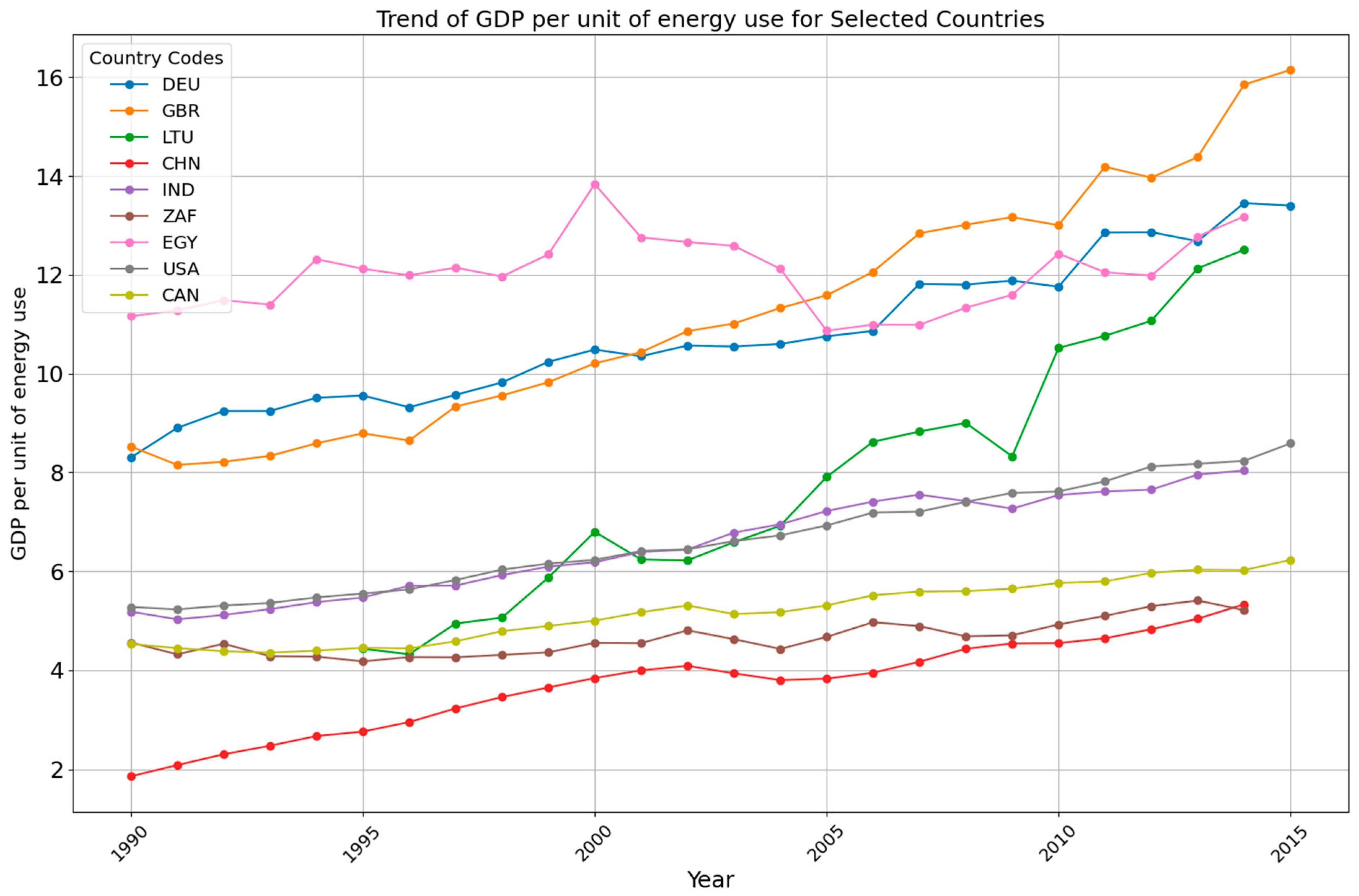
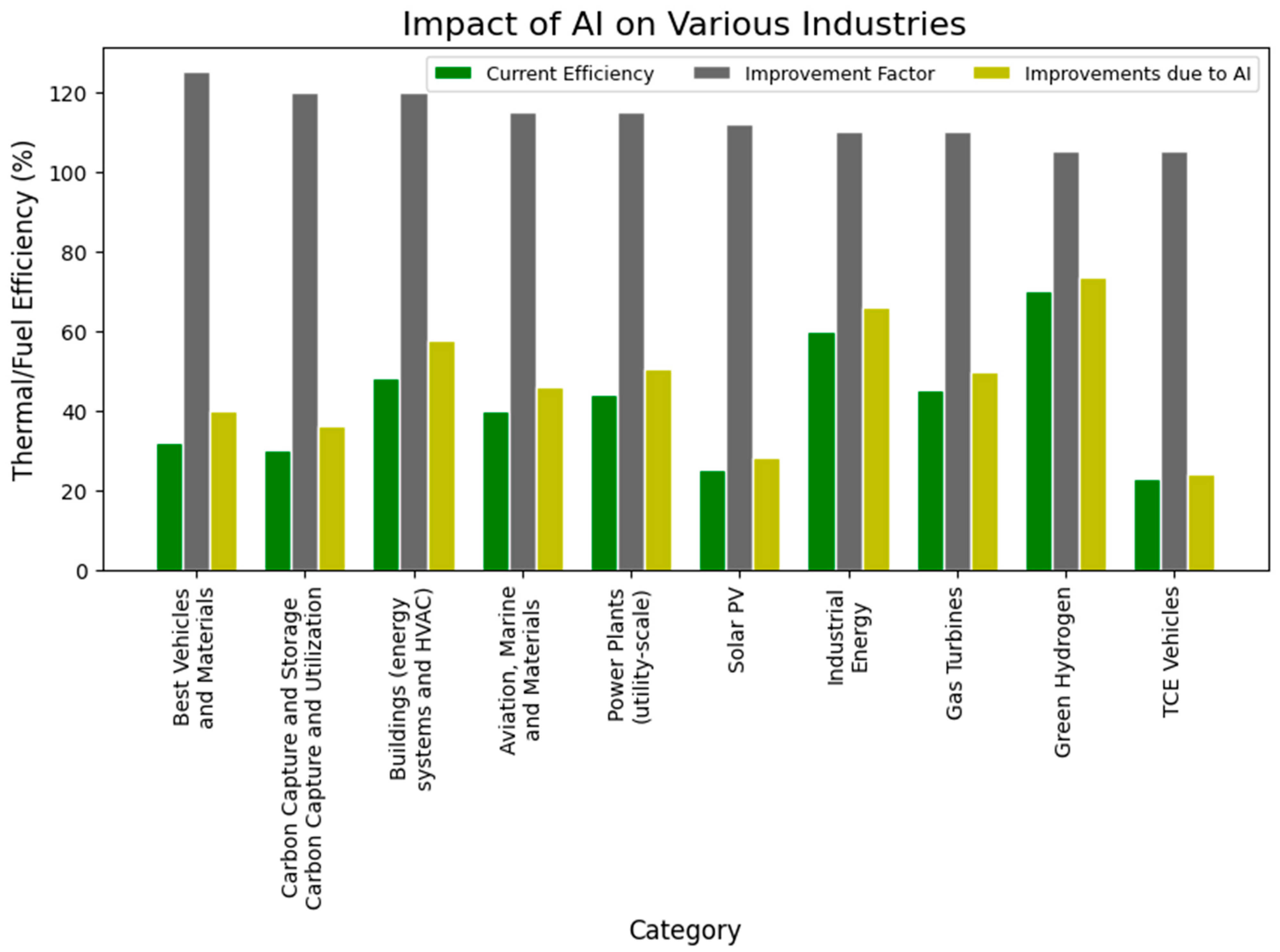
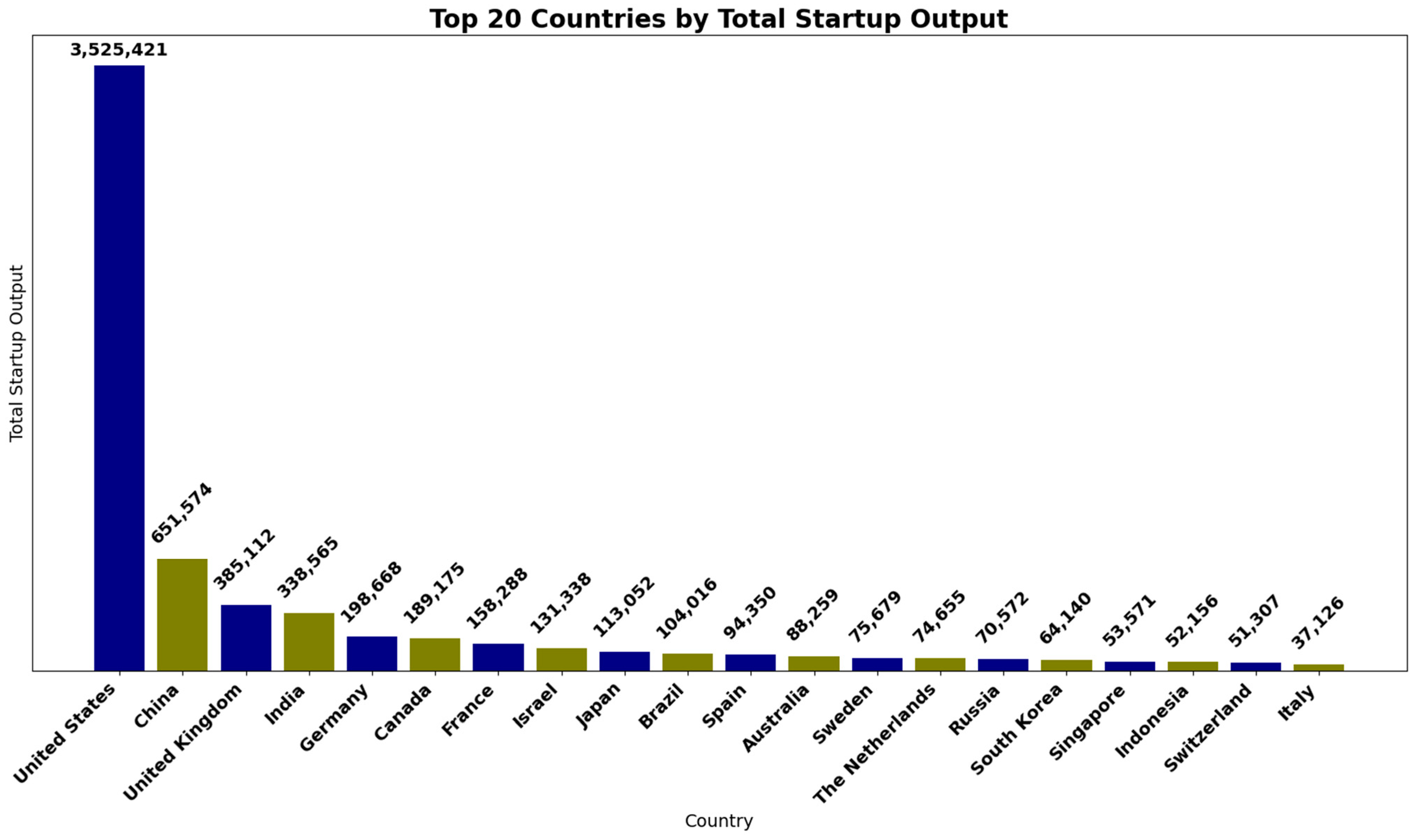
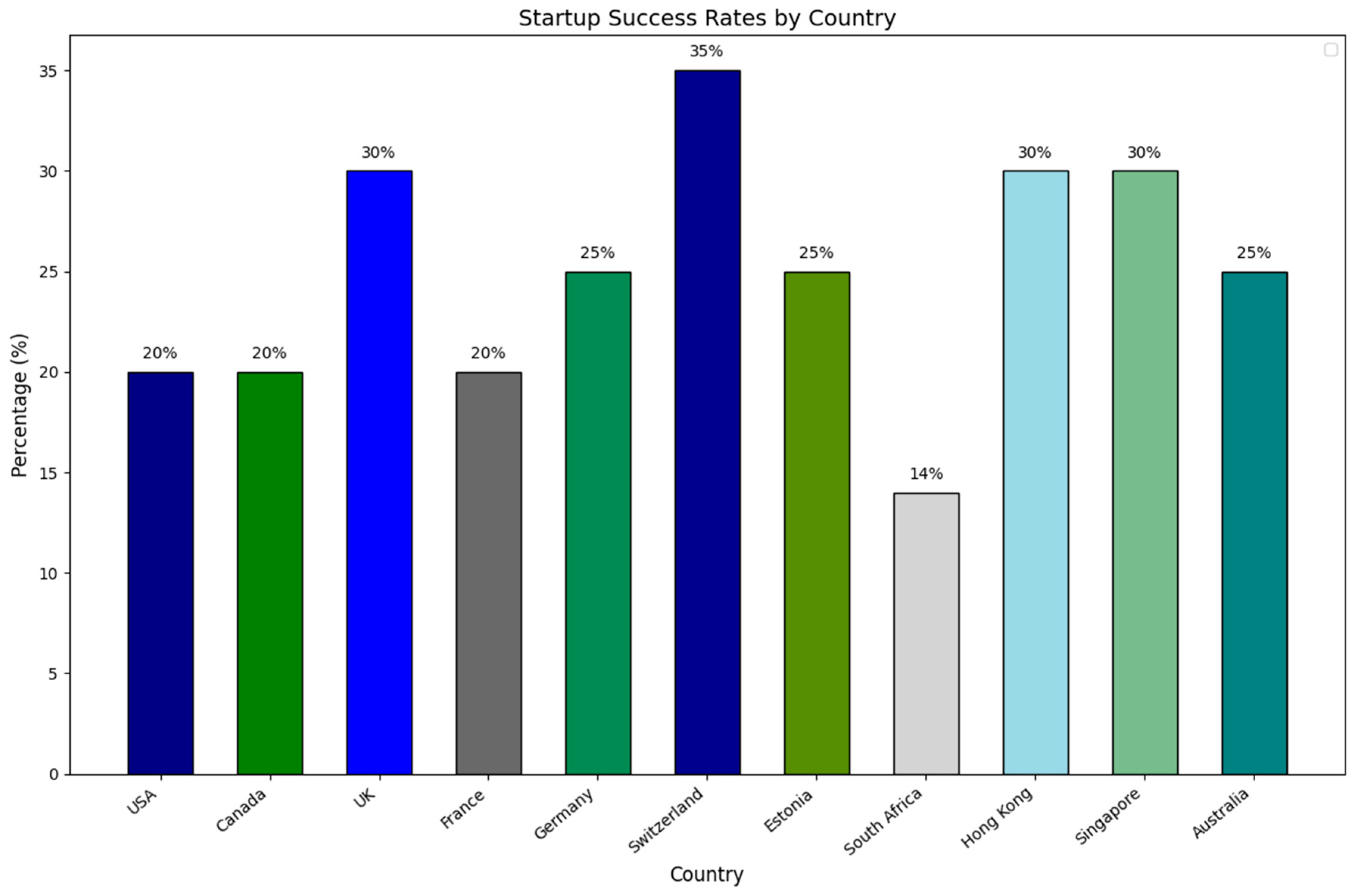
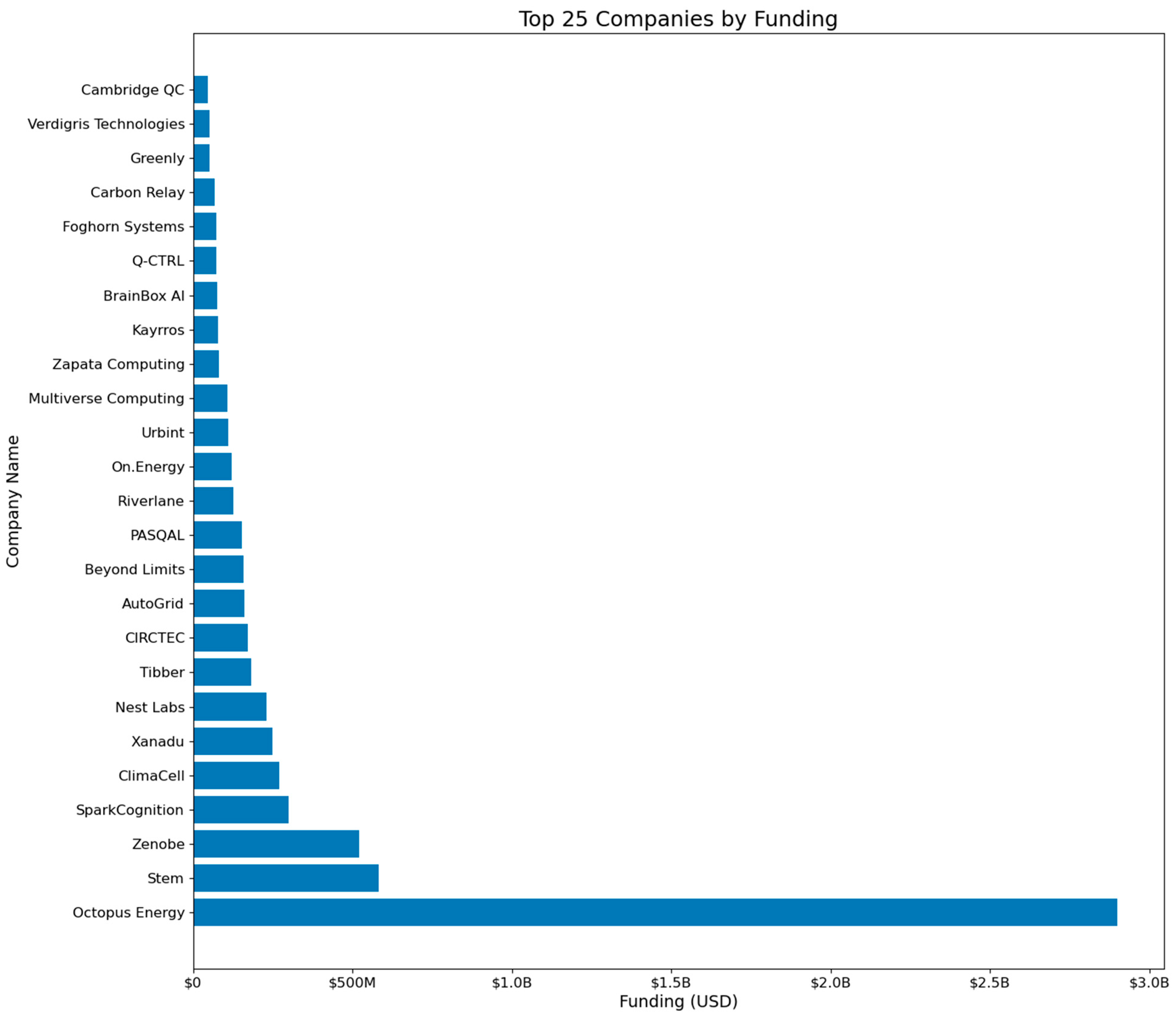

| NO | Company Name | Country | Funding (USD) | Business Focus, Technology Focus, and Primary Activity Areas |
|---|---|---|---|---|
| 1 | Octopus Energy | UK | 2.9B | AI-powered smart grid solutions and power distribution for energy/utilities sector |
| 2 | Stem | USA | 582.6M | AI-powered energy storage solutions for cost savings in energy industry |
| 3 | Zenobe | UK | 522M | Electric vehicle fleet management and battery storage services |
| 4 | SparkCognition | USA | 300M | AI- software for safety and reliability in energy and security sectors |
| 5 | ClimaCell | USA | 270.9M | Weather intelligence and optimization for energy operations |
| 6 | Xanadu | Canada | 250M | Photonic quantum computing solutions for energy, finance, and chemistry |
| 7 | Nest Labs | USA | 230M | Smart home energy management products using hardware and IoT |
| 8 | Tibber | France | 181.2M | AI-driven dynamic power management for electricity supply |
| 9 | CIRCTEC | UK | 172M | Green tech solutions focusing on tire recycling |
| 10 | AutoGrid | USA | 161M | Energy data analytics and predictions for big data in energy industry |
| 11 | Beyond Limits | USA | 158.5M | Enterprise-grade AI solutions for industrial applications including energy |
| 12 | PASQAL | France | 152M | Quantum computing for complex simulations in material science and energy optimization |
| 13 | Riverlane | UK | 125M | Quantum- software for materials science in energy and pharmaceuticals |
| 14 | On. Energy | USA | 120M | AI-driven energy storage management for grid-scale projects |
| 15 | Urbint | USA | 109M | Predictive analytics for infrastructure and energy operations |
| 16 | Multiverse Computing | Spain | 108M | Quantum computing, AI, and optimization for energy sector |
| 17 | Zapata Computing | USA | 82.1M | Quantum- software solutions for energy, finance, and pharmaceuticals |
| 18 | Kayrros | Canada | 78.6M | Data analytics for energy market investment decisions |
| 19 | BrainBox AI | Canada | 75.1M | AI for HVAC optimization in buildings |
| 20 | Q-CTRL | Australia | 74M | Quantum control solutions for energy, aerospace, and finance |
| 21 | Foghorn Systems | USA | 72.5M | IoT and ML platform for energy applications |
| 22 | Carbon Relay | USA | 68M | AI for data center cooling optimization in energy sector |
| 23 | Greenly | France | 52M | Carbon accounting platform for climate tech sector |
| 24 | Verdigris Technologies | USA | 51.5M | AI-powered energy consumption optimization (SaaS) |
| 25 | Cambridge QC | UK | 45M | Quantum- software for energy, cybersecurity, and drug discovery |
| 26 | 1QBit | Canada | 45M | Quantum-inspired software for energy, finance, and life sciences |
| 27 | METRON | France | 43M | AI-powered energy intelligence platform |
| 28 | Worlds | USA | 38M | IoT and AI solutions for physical space analysis in energy sector |
| 29 | QC Ware | Canada | 33.2M | Quantum algorithms for energy, finance, and aerospace industries |
| 30 | C12 Quantum Electronics | France | 29.4M | Quantum computing hardware for energy applications |
| 31 | Ambyint | Canada | 29.1M | AI-driven optimization for oil and gas production |
| 32 | SmartCat | Serbia | 28.9M | AI-powered heating and cooling device optimization |
| 33 | QiO Technologies | UK | 27.18M | AI-driven sustainability solutions for emissions reduction |
| 34 | Phasecraft | UK | 26.3M | Quantum algorithms to optimize energy grids |
| 35 | Osperity | USA | 25.6M | AI-driven visual monitoring for industrial operations in energy sector |
| 36 | Energy X | South Korea | 25.4M | AI-driven platform for renewable energy investment |
| 37 | Innowatts | USA | 24.3M | AI platform for energy providers |
| 38 | Strangeworks | USA | 24M | Quantum computing ecosystem for energy, finance, and aerospace |
| 39 | Jua | Switzerland | 21.5M | AI for weather-dependent energy trading |
| 40 | Grid4C | Israel | 13M | AI and ML for smart grid optimization |
| 41 | LightSolver | Israel | 13.7M | Energy-efficient supercomputer development using quantum computing |
| 42 | Dexter Energy | Netherlands | 12.5M | AI-based energy forecasting and dispatching solutions |
| 43 | BluWave-ai | Canada | 10.92M | AI solutions for energy grids and renewable energy |
| 44 | Raycatch | Israel | 10.2M | AI-driven asset management for solar energy |
| 45 | Buzz Solutions | USA | 9.5M | AI for power line maintenance in energy infrastructure |
| 46 | Quantum Benchmark | Canada | 9.16M | Quantum error diagnostics for energy, finance, and defense sectors |
| 47 | Flutura | India | 8.5M | AI platform for industrial asset optimization in energy sector |
| 48 | Myst AI | USA | 8M | AI-based electricity demand and supply forecasting |
| 49 | Blue Wave AI Labs | USA | 6.9M | AI for nuclear reactor operations |
| 50 | Skyqraft | Sweden | 6.9M | ML-powered aerial inspection for power lines |
| 51 | Limejump | UK | 5.5M | AI platform for renewable energy aggregation |
| 52 | Invenia | Canada | 5M | ML platform for electric utility optimization |
| 53 | Dabbel | Germany | 4.4M | AI-based energy management systems for buildings |
| 54 | ANNEA | Germany | 4.142M | AI-driven maintenance for renewable energy assets |
| 55 | Ogre AI | Romania | 2.834M | ML-based decision support for energy and utilities |
| 56 | Qu & Co | Netherlands | 2.7M | Quantum computational- software for energy, chemistry, and finance |
| 57 | R8tech | Estonia | 2.616M | AI add-ons for building automation systems |
| 58 | COI Energy Services | USA | 2.5M | AI and blockchain for energy efficiency improvement |
| 59 | Ossus Biorenewables | India | 2.364M | AI-powered green hydrogen production from waste carbon |
| 60 | Tablepointer | Singapore | 2.25M | AI for commercial energy usage optimization |
| 61 | SMPnet | UK | 1.4M | AI-powered grid control software for energy service providers |
| 62 | Nnergix | Spain | 1M | AI-powered weather analytics for renewable energy forecasting |
| 63 | Quant Co | - | 555.2K | AI as a Service for home energy management and smart grid |
| 64 | Capalo AI | Finland | 545K | AI platform for the energy industry |
| 65 | Quadrical. Ai | Canada | 450K | AI-based solar plant monitoring and forecasting |
| 66 | Sync Energy | USA | 376K | AI-based analytics for electrical utilities |
| 67 | Rezlytix Technologies | India | 200K | AI solutions for oil and gas optimization |
| 68 | Hank | USA | 150K | AI-powered HVAC management in the energy sector |
| 69 | Kapacity.io | Finland | 125K | AI/ML for HVAC energy consumption optimization |
| 70 | NRGI.ai | Ireland | 120K | AI-based B2B energy trading marketplace |
| 71 | Eneryield | Sweden | 120K | ML solutions for electric power system fault prediction |
| 72 | Sobolt | Netherlands | 56.5K | AI for building heat loss mapping in the energy efficiency sector |
| 73 | Kagera AI | Serbia | - | ML and DL for oil and gas production optimization |
| 74 | DeepMind | UK | - | AI research and applications in energy efficiency |
| 75 | Evolve Energy | USA | - | AI and IoT solutions for consumer energy cost savings |
| 76 | Neurons Lab | Ukraine | - | AI solutions for energy station optimization |
| 77 | AIDI.solar | Ukraine | - | AI and ML for solar power plant management |
| 78 | Leanheat | Finland | - | AI for climate control optimization in buildings |
| 79 | Nesh | USA | - | AI assistant for oil and gas industry decision support |
Disclaimer/Publisher’s Note: The statements, opinions and data contained in all publications are solely those of the individual author(s) and contributor(s) and not of MDPI and/or the editor(s). MDPI and/or the editor(s) disclaim responsibility for any injury to people or property resulting from any ideas, methods, instructions or products referred to in the content. |
© 2024 by the authors. Licensee MDPI, Basel, Switzerland. This article is an open access article distributed under the terms and conditions of the Creative Commons Attribution (CC BY) license (https://creativecommons.org/licenses/by/4.0/).
Share and Cite
Mohammadi Lanbaran, N.; Naujokaitis, D.; Kairaitis, G.; Jenciūtė, G.; Radziukynienė, N. Overview of Startups Developing Artificial Intelligence for the Energy Sector. Appl. Sci. 2024, 14, 8294. https://doi.org/10.3390/app14188294
Mohammadi Lanbaran N, Naujokaitis D, Kairaitis G, Jenciūtė G, Radziukynienė N. Overview of Startups Developing Artificial Intelligence for the Energy Sector. Applied Sciences. 2024; 14(18):8294. https://doi.org/10.3390/app14188294
Chicago/Turabian StyleMohammadi Lanbaran, Naiyer, Darius Naujokaitis, Gediminas Kairaitis, Gabrielė Jenciūtė, and Neringa Radziukynienė. 2024. "Overview of Startups Developing Artificial Intelligence for the Energy Sector" Applied Sciences 14, no. 18: 8294. https://doi.org/10.3390/app14188294
APA StyleMohammadi Lanbaran, N., Naujokaitis, D., Kairaitis, G., Jenciūtė, G., & Radziukynienė, N. (2024). Overview of Startups Developing Artificial Intelligence for the Energy Sector. Applied Sciences, 14(18), 8294. https://doi.org/10.3390/app14188294






